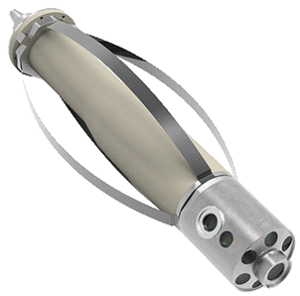During the process of evacuating materials such as wheat, lime, cement, or flour from the silo, the lower nozzle may get clogged due to two reasons. The first reason is known as a rat hole which is a hole that expands throughout the silo. This prevents the flow of materials into the lower nozzles causing particles to accumulate. The second reason is called bridging which creates an arc ceiling that interrupts the flow into the lower nozzles. These issues reduce the efficiency of the storage silos due to the partial evacuation of the particles from the silo. The stack angle, granulation size, silo cone angle, moisture level, material type, material surface smoothness, and outlet nozzle diameter are factors that contribute to these two phenomena.
Although there exist several solutions to tackle this issue they all have their limitations and drawbacks. To address these problems equipment is required to break bridges and eliminate rat holes without human intervention.
One of the simplest ways to solve the issue is by using inspection valves and mandrels to break the bridges that have formed. Another method is to apply vibration to break the bridges and restart the flow. However, this technique is not suitable for concrete silos. Moreover, the vibration of metal silos may create tension in the welding seam connections leading to a failure of the silo.
The Nitro-Pulse® gun is designed to address problems related to fluid flow. It acts as an automated valve that can interrupt and reconnect the flow quickly. This device is similar to an automatic pneumatic valve that releases compressed air within 0.03 to 0.1 seconds depending on its design.
The design of this gun is in such a way that the gaseous fluid such as air or nitrogen is pressurized through the inlet nozzle of the gas pulse generator device and collects in the preload chamber. Then the gaseous fluid enters the pressure chamber through the pore that is in the center of the piston. As gas accumulates in the high-pressure chamber its pressure increases and approaches that of the preload chamber. The resulting force enters the upper surface of the piston from the gas in the preload chamber while the force generated by the gas in the high-pressure chamber enters its lower surface. The combined force pushes the piston upwards resulting in its upward movement and the activation of the actualvator with high acceleration.
The generator is designed to work with gaseous fluids such as air or nitrogen. The fluid enters the generator through the inlet nozzle and collects in the preload chamber. From there the fluid enters the pressure chamber through the hole in the piston’s center. As the gas accumulates in the high-pressure chamber its pressure increases and approaches that of the preload chamber. The force from the accumulation of gas in the preload chamber enters the upper surface of the piston while the force from the high-pressure chamber enters the lower surface. This causes upward forces on the piston causing it to move upwards.
As the piston moves up the actuator works pushing the piston with a high acceleration. The air trapped in the high-pressure chamber is then released as the piston passes in front of the outlet nozzle. The air trapped in the brake chamber slows the piston down as it moves up. Once the air exits the high-pressure chamber the piston is pushed down again and the air exit path is blocked. By blocking the exit air path the air pressure in the pressure chamber rises to match that of the preload chamber and the cycle repeats.
The application of this gun is in silos as well as water and oil well rehabilitation.

